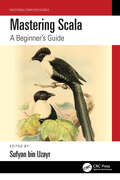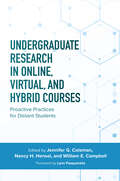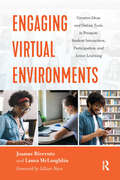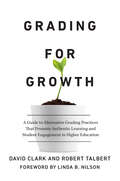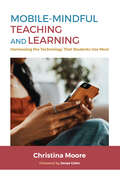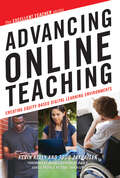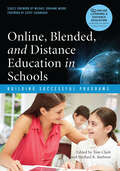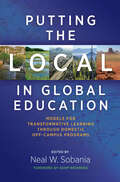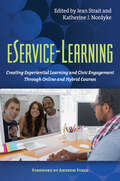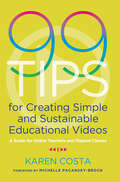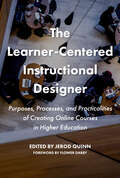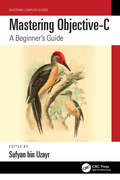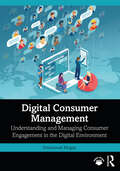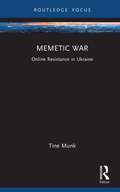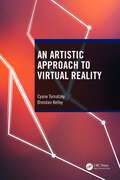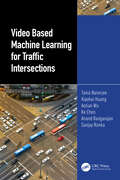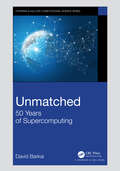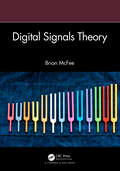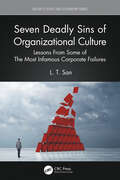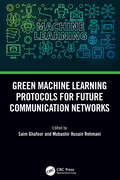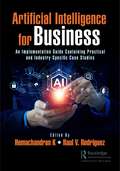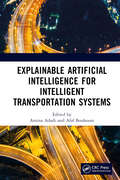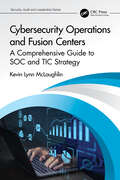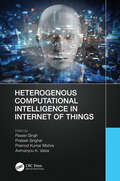- Table View
- List View
Mastering Scala: A Beginner's Guide (Mastering Computer Science)
by Sufyan Bin UzayrScala is a multi-paradigm, general-purpose scripting language. It is a completely object-oriented programming language that supports a functional programming technique. This book is a detailed guide for beginners to understand Scala. Concise and easy to understand, Mastering Scala: A Beginner’s Guide covers a comprehensive understanding of Scala and its components, libraries, and advance concepts to help readers quickly advance with the necessary information. This book provides functional approaches for solving queries using Scala. The fundamental principles of Scala explained here are helpful to beginner and intermediate users interested in learning this highly technical and diverse language. Key Features: Follows a hands-on approach and offers practical lessons and tutorials related to Scala Includes detailed tutorials meant for beginners to Scala Discusses Scala in-depth to help build robust knowledge
Undergraduate Research in Online, Virtual, and Hybrid Courses: Proactive Practices for Distant Students
by Nancy H. Hensel Jennifer G. Coleman Wm. E. CampbellCo-published with and With the growing interest in undergraduate research as a high-impact practice, and the recognition that college education is increasingly moving online, this book – the first to do so – provides a framework, guidance from pioneering practitioners, and a range of examples across disciplines on how to engage remote students in research.Two foundational chapters set the scene. For those new to incorporating undergraduate research in their courses, the opening chapter provides an introduction to its evolution and practice, and reviews the evidence of its benefits for students, faculty, and institutions. The second addresses the benefit that undergraduate research can bring to online learning and provides an overview of the ways research can be incorporated into online and virtual courses to meet the course and student learning objectives. The remaining chapters illustrate implementation of undergraduate research in courses across many disciplines. They address thematic issues related to the work and its effects on students, such as transitioning them from users of, to active participants in, research; and consideration of the technological tools needed to support students in a virtual environment. The contributors, some of whom have been implementing these practices for some years, offer important insights and expertise.While the examples range across the behavioral sciences, business, education, the health professions, the humanities, social sciences, and STEM, readers will find much of value and inspiration from reading the chapters beyond their disciplines.
Engaging Virtual Environments: Creative Ideas and Online Tools to Promote Student Interaction, Participation, and Active Learning
by Joanne Ricevuto Laura McLaughlinIn a classroom setting interaction among students is the norm. How do you replicate that informality, spontaneity, and focus online? This book provides you with a framework to think about the different kinds of engagement you want to foster -- whether participation, collaboration, or quick feedback -- and then introduces you to available online tools, some of which may be in your LMS, offers practical tips, and guides you to how make the most of commonly available technologies to achieve your goals.Within the context and progression of a course -- from developing a welcome page, presenting yourself and the purpose of your course, to icebreakers, assignments, and alternative forms of assessment -- the authors introduce you to a range of easy-to-use online tools that they have introduced to the faculty and teachers in their classes, and that foster active learning and student engagement. In doing so they provide a checklist that you can also access and print from the Web, to help you review additional tools from the wide and ever-growing range of tools that are available online and determine whether they are appropriate for what you want to accomplish.This book will help you connect with students, whether you’re teaching synchronously or asynchronously, regardless of the devices students may be using; develop community; and introduce you to gamification to add enjoyment and variety to your students’ experience of your class.Recognizing that using new tools with confidence requires practice, the authors offer ideas for implementing them in private online spaces. Each chapter concludes with reflection questions that can be addressed individually by the reader or within a learning community to encourage faculty to work together and support each other in virtual teaching and learning. This book addresses the challenge of embracing new models of course offerings to students in the evolving landscape of virtual learning.
Grading for Growth: A Guide to Alternative Grading Practices that Promote Authentic Learning and Student Engagement in Higher Education
by David Clark Robert TalbertAre you satisfied with your current and traditional grading system? Does it accurately reflect your students’ learning and progress? Can it be gamed? Does it lead to grade-grubbing and friction with your students?The authors of this book – two professors of mathematics with input from colleagues across disciplines and institutions – offer readers a fundamentally more effective and authentic approach to grading that they have implemented for over a decade. Recognizing that traditional grading penalizes students in the learning process by depriving them of the formative feedback that is fundamental to improvement, the authors offer alternative strategies that encourage revision and growth.Alternative grading is concerned with students’ eventual level of understanding. This leads to big changes: Students take time to review past failures and learn from them. Conversations shift from “why did I lose a point for this” to productive discussions of content and process.Alternative grading can be used successfully at any level, in any situation, and any discipline, in classes that range from seminars to large multi-section lectures.This book offers a comprehensive introduction to alternative grading, beginning with a framework and rationale for implementation and evidence of its effectiveness. The heart of the book includes detailed examples – including variations on Standards-Based Grading, Specifications Grading, and ungrading -- of how alternative grading practices are used in all kinds of classroom environments, disciplines and institutions with a focus on first-hand accounts by faculty who share their practices and experience. The book includes a workbook chapter that takes readers through a step-by-step process for building a prototype of their own alternatively graded class and ends with concrete, practical, time-tested advice for new practitioners.The underlying principles of alternative grading involve·Evaluating student work using clearly defined and context-appropriate content standards.·Giving students helpful, actionable feedback.·Summarizing the feedback with marks that indicate progress rather than arbitrary numbers.·Allowing students to revise without penalty, using the feedback they receive, until the standards are met or exceeded.This book is intended for faculty interested in exploring alternative forms of learning assessment as well as those currently using alternative grading systems who are looking for ideas and options to refine practice.
Grading for Growth: A Guide to Alternative Grading Practices that Promote Authentic Learning and Student Engagement in Higher Education
by David Clark Robert TalbertAre you satisfied with your current and traditional grading system? Does it accurately reflect your students’ learning and progress? Can it be gamed? Does it lead to grade-grubbing and friction with your students?The authors of this book – two professors of mathematics with input from colleagues across disciplines and institutions – offer readers a fundamentally more effective and authentic approach to grading that they have implemented for over a decade.Recognizing that traditional grading penalizes students in the learning process by depriving them of the formative feedback that is fundamental to improvement, the authors offer alternative strategies that encourage revision and growth.Alternative grading is concerned with students’ eventual level of understanding. This leads to big changes: Students take time to review past failures and learn from them. Conversations shift from “why did I lose a point for this” to productive discussions of content and process.Alternative grading can be used successfully at any level, in any situation, and any discipline, in classes that range from seminars to large multi-section lectures. This book offers a comprehensive introduction to alternative grading, beginning with a framework and rationale for implementation and evidence of its effectiveness. The heart of the book includes detailed examples – including variations on Standards-Based Grading, Specifications Grading, and ungrading -- of how alternative grading practices are used in all kinds of classroom environments, disciplines and institutions with a focus on first-hand accounts by faculty who share their practices and experience. The book includes a workbook chapter that takes readers through a step-by-step process for building a prototype of their own alternatively graded class and ends with concrete, practical, time-tested advice for new practitioners.The underlying principles of alternative grading involve·Evaluating student work using clearly defined and context-appropriate content standards.·Giving students helpful, actionable feedback.·Summarizing the feedback with marks that indicate progress rather than arbitrary numbers.·Allowing students to revise without penalty, using the feedback they receive, until the standards are met or exceeded.This book is intended for faculty interested in exploring alternative forms of learning assessment as well as those currently using alternative grading systems who are looking for ideas and options to refine practice.
Mobile-Mindful Teaching and Learning: Harnessing the Technology That Students Use Most
by Christina MooreThis book provides faculty and instructors with an introductory guide to integrating mobile learning in their courses. Recognizing that a smartphone is the first and main piece of technology anyone owns, with ownership exceeding 95% for those aged 18-29, with a sizable minority of these being smartphone-dependent; and that instructors are relying on technology for teaching and learning more than ever; this book addresses the imperative that course materials and interactions be increasingly available through the technology that students use most often. Dispelling the notion that mobile learning is for the tech-savvy and adventurous, mobile-mindful teaching offers teachers a way to take a few steps at a time, share options with students, and progressively develop ideas and practices. The book invites you to explore your own way into mobile learning.Christina Moore stresses two principles as you engage with mobile learning--intention and fluidity. This begins with mindfully implementing mobile learning opportunities so that students see the usefulness of learning via phone; and recognizing the fluid learning environments in which students learn so you can offer online modalities and functions appropriate to purpose and situations.The book opens with a “start with self” section on How to Be a Mobile Mindful Learner, offering ideas on exploring the almost infinite available online resources in your discipline to curate a rich and ever-expanding compilation of ideas for use in your scholarly work and teaching; and identifying different types of learning (digital reading, audio and visual learning, and social learning) across multiple devices and contexts to consider as you develop your course.The section “Toward Mobile-Mindful Teaching” explores ways to add mobile options to existing learning materials and how they and the LMS functions you use are rendered on a phone by taking a mobile test drive through your course.Christina Moore shows how, by building up your mobile learning skills to be a more productive scholar and developing habits that feed your curiosity and creativity, you can start planning how you can create fluid learning opportunities for your students they can access across devices, time, and space, and take advantage of found moments of time and informal spaces.
Advancing Online Teaching: Creating Equity-Based Digital Learning Environments
by Kevin Kelly Todd D. ZakrajsekThe goal of teaching online is fundamentally the same as teaching face-to-face: facilitating the learning of all students to the greatest extent possible. This book differs from other books on online teaching in that, in the process of offering guidance on course design and planning, developing outcomes and appropriate engaging activities, managing the workload and assessment, the authors pay explicit attention throughout to the distinct and diverse needs of students and offer effective strategies to accommodate them in a comprehensive and inclusive way by using the principles of Universal Design for Learning. By following those principles from the outset when planning a course, all students will benefit, and most particularly those whom the research shows have the greatest achievement gaps when taking online courses -- males, first generation and low income students, those from underrepresented minority groups, the academically underprepared, students with disabilities, and those with limited online access or lacking readiness for online learning. Beyond good planning and design, Kelly and Zakrajsek offer ideas for creating inclusive course environments and activities, such as using culturally appropriate content and making it accessible in multiple formats. They also share methods to foster faculty-learner interaction and increase personal connections with students, and among students, through group activities or learning communities, which are so critical to motivation and success. Faculty new to online teaching as well as more experienced readers will find a wealth of practical guidance on developing and honing both fully online and blended courses and, as importantly, a wealth of proven ideas to help the new generation of students with diverse needs to succeed.
Online, Blended, and Distance Education in Schools: Building Successful Programs (Higher Education Ser.)
by Tom Clark Michael Grahame Moore Cathy Cavanaugh Michael K. BarbourCo-Published with the Microsoft Corporation Online, Blended and Distance Education in Schools provides students enrolled in Education Technology, Educational Administration and related Masters and PhD programs with expert opinions and insights on the practice and policy in K-12 online, blended and distance education, online and blended programs, including curriculum, instruction, technology and management aspects. It describes the status and trends of the field, provides illustrative program examples, explores the issues and challenges that programs face and highlights ongoing research in key areas related to program effectiveness. Topics discussed:* The current status of K-12 online, distance and blended learning in the U.S.* Policy, funding, and management issues in relation to program implementation* Research on effective programs within governmental jurisdiction and various program types* Global case studies that represent the variety of ways programs are being successfully implemented * A synthesis of key findings and lessons learned, and local and global visions for the future of K-12 distance and online learningThis text is highly appropriate for students enrolled in Educational Technology, Educational Administration and related Masters and PhD programs. An online companion resource provides pedagogical features that enhance text use in a classroom setting.
Putting the Local in Global Education: Models for Transformative Learning Through Domestic Off-Campus Programs
by Neal W. SobaniaThe position taken in this volume is that domestic off-campus study can be just as powerful a transformative learning experience as study overseas, and that domestic programs can equally expand students’ horizons, their knowledge of global issues and processes, their familiarity and experience with cultural diversity, their intercultural skills, and sense of citizenship.This book presents both the rationale for and examples of “study away”, an inclusive concept that embraces study abroad while advocating for a wide variety of domestic study programs, including community-based education programs that employ academic service-learning and internships.With the growing diversification—regionally, demographically, culturally, and socio-economically—of developed economies such as the US, the local is potentially a “doorstep to the planet” and presents opportunities for global learning. Moreover, study away programs can address many of the problematic issues associated with study abroad, such as access, finance, participation, health and safety, and faculty support. Between lower costs, the potential to increase the participation of student cohorts typically under-represented in study abroad, the lowering of language barriers, and the engagement of faculty whose disciplines focus on domestic issues, study at home can greatly expand the reach of global learning.The book is organized in five sections, the first providing a framework and the rationale for domestic study way programs; addressing administrative support for domestic vs. study abroad programs; exploring program goals, organization, structure, assessment and continuous improvement; and considering the distinct pedagogies of experiential and transformative education.The second section focuses on Semester Long Faculty Led Programs, featuring examples of programs located in a wide variety of locations – from investigations into history, immigration, culture, and the environment through localities in the West and the Lowcountry to exploring globalization in L.A and New York. Section three highlights five Short Term Faculty Led Programs. While each includes an intensive immersive study away experience, two illustrate how a 7 – 10 day study away experience can be effectively embedded into a regular course taught on campus. The fourth section, on Consortium Programs, describes programs that are either sponsored by a college that makes its program available to consortium members and non-members, or is offered by an independent non-for-profit to which institutions send their students. The final section on Community Engagement and Domestic Study Away addresses the place of community-based education in global learning and provides examples of academic programs that employ service-learning as a tool for collaborative learning, focusing on issues of pedagogy, faculty development and the building long-term reciprocal relationship with community partners to co-create knowledge.The book is intended for study abroad professionals, multicultural educators, student affairs professionals, alternative spring break directors, and higher education administrators concerned about affordably expanding global education opportunities.
eService-Learning: Creating Experiential Learning and Civic Engagement Through Online and Hybrid Courses
by Jean Strait Katherine J. NordykeThis book serves as an introduction to using online teaching technologies and hybrid forms of teaching for experiential learning and civic engagement. Service-learning has kept pace neither with the rapid growth in e-learning in all its forms nor with the reality that an increasing number of students are learning online without exposure to the benefits of this powerful pedagogy.Eservice-learning (electronic service-learning) combines service-learning and on-line learning and enables the delivery of the instruction and/or the service to occur partially or fully online. Eservice-learning allows students anywhere, regardless of geography, physical constraints, work schedule, or other access limitations, to experience service-learning. It reciprocally also equips online learning with a powerful tool for engaging students.In eservice-learning, the core components of service, learning, and reflection may take a different form due to the online medium—for example, reflection often occurs through discussion board interactions, journals, wikis, or blogs in an eservice-learning course. Moreover, the service, though still community-based, creates a world of opportunities to connect students with communities across the globe—as well as at their very own doorstep.This book introduces the reader to the four emerging types of eservice-learning, from Extreme EService-Learning (XE-SL) classes where 100% of the instruction and 100% of the service occur online, to three distinct forms of hybrid where either the service or the instruction are delivered wholly on-line – with students, for instance, providing online products for far-away community partners – or in which both are delivered on-site and online. It considers the instructional potential of common mobile technologies – phones, tablets and mobile reading devices. The authors also address potential limitations, such as technology challenges, difficulties sustaining three-way communication among the instructor, community partner, and students, and added workload.The book includes research studies on effectiveness as well as examples of practice such drafting grants for a community partner, an informational technology class building online communities for an autism group, and an online education class providing virtual mentoring to at-risk students in New Orleans from across the country.
99 Tips for Creating Simple and Sustainable Educational Videos: A Guide for Online Teachers and Flipped Classes
by Karen CostaThe research is clear: online learning works best when faculty build regular, positive, and interactive relationships with students. A strategy that helps forge such a relationship is the use of videos. Student satisfaction and course engagement levels also increase with the use of instructor-generated videos – the subject of this book.Beginning by outlining the different types of videos you can create, and what the research says about their effectiveness, Karen Costa explains how they can be designed to reinforce learning, to align with and promote course outcomes, and to save you time across your courses. She then describes how to create successful videos with commonly available technologies such as your smartphone, and without a major investment of time, demonstrating the simple steps she took to develop her bank of videos and build her confidence to deliver short, straightforward learning aids that are effective and personal.Embedded QR codes in the text enable you to view sample videos and screencasts that bring the book’s advice to life as you read.If you’ve been wanting to include videos in your teaching but haven’t found the time or confidence, this book will help you to develop a simple and sustainable video development process, supporting both your success and the success of your students.
The Learner-Centered Instructional Designer: Purposes, Processes, and Practicalities of Creating Online Courses in Higher Education
by Flower Darby Jerod Quinn“What does a new instructional designer need to know to find her or his feet when working with faculty to create online classes?” This is a practical handbook for established and aspiring instructional designers in higher education, readers who may also be identified by such professional titles as educational developer, instructional technologist, or online learning specialist. Jerod Quinn, together with a team of experienced instructional designers who have worked extensively with a wide range of faculty on a multiplicity of online courses across all types of institutions, offer key guiding principles, insights and advice on how to develop productive and collegial partnerships with faculty to deliver courses that engage students and promote enduring learning.Designing and developing online classes for higher education takes a combination of pedagogical knowledge, the ability to build trust with faculty, familiarity with frameworks on how people learn, understanding of accessibility and inclusion, and technical skills to leverage a learning management system into an educational experience. Coming from diverse backgrounds, few instructional designers enter academia well versed in all of these aspects of creating online classes. This book provides the foundation on which instructional designers can build their careers. The guiding principle that animates this book is that the student experience and successful learning outcomes are paramount, and governs discussion of course design, pedagogy, the use of multimedia and technological advances, as well as the use of different forms of interactive exercises and group assignments. The succinct, informally written chapters offer ideas and means to apply theory to the daily work of instructional design and cover the four key components that drive this work in higher education: ·Defining the scope and main design approaches of our work·Building trust with the faculty we work with·Applying frameworks of how people learn·Mastering common online instructional practices.
Mastering Objective-C: A Beginner's Guide (Mastering Computer Science)
by Sufyan Bin UzayrMastering Objective-C is a detailed guide for beginners that gives a modern programmer’s viewpoint on Objective-C. It introduces the principles of Objective-C and current Apple programming skills and libraries allowing the reader to make the best use of the tools available. Concise and easy to understand, this book covers many topics including, an introduction to key concepts of language and primary toolkits, as well as the Foundation and AppKit frameworks to help quickly advance with the necessary information. This book explains how to structure applications properly and organize code for optimum performance. The fundamental principles explained here are helpful to beginner and intermediate users interested in learning this highly technological and diverse language.
Digital Consumer Management: Understanding and Managing Consumer Engagement in the Digital Environment
by Emmanuel MogajiIntegrating consumer behaviour, digital marketing, digital platform management, web analytics, and marketing insights, Digital Consumer Management provides a holistic understanding—from a brand perspective—of the management of consumers and consumption in the digital ecosystem. Chapters explore the key stakeholders in platform management, the multiple types of platforms used by brands, the various consumer-brand touchpoints, how the platforms are developed and with what goals in mind, managing consumer engagement and activities on these platforms, how the platforms are regulated, and the dark side of digital consumption. Theory is brought to life by practical examples and case studies from across sectors, and reflective questions and activities allow students to critically reflect on their learning. Providing a comprehensive picture of digital consumption activities, digital consumer behaviour across platforms, and how brands can manage and engage with the digital consumer, this text works as core and recommended reading for students studying digital consumer behaviour, digital marketing, and marketing management. Accompanying online resources include PowerPoint slides and an instructor’s manual.
Memetic War: Online Resistance in Ukraine (Routledge Studies in Crime and Society)
by Tine MunkMemetic War analyses memetic warfare included in cyber war and aims to develop a framework for understanding the parameters included in utilising this concept in Ukraine as a part of civic resistance.In the Ukrainian war, an informal defence tactic has developed to uphold the information flow about the war and to debunk Russia’s communications. The war has enhanced the visibility of governmental and civic activation by using the advantages of social media architecture, networks, and communication forms. The book investigates Ukraine’s public and private abilities to develop cyber capabilities to counter propaganda and dis-and-misinformation online as a defence mechanism. This book uses military ROC doctrine to understand government authorities, the armed forces, and civic engagement in the Ukrainian resistance.Memetic War will have relevance for scholars, researchers, and academics in the cybersecurity field, practitioners, governmental actors, and military and strategic personnel.
An Artistic Approach to Virtual Reality
by Cyane Tornatzky Brendan KelleyA special quality about the medium of virtual reality is its immersive nature, allowing users to disengage from the physical world around them in order to fully interact with a digital environment. An Artistic Approach to Virtual Reality traces the lineage of artist/technologists who have worked with virtual reality in its infancy to the interactive virtual work of contemporary artists such as Laurie Anderson. Interlaced within a survey of artists whose works fit in the boundary of the interactive virtual medium, this book teases out what qualifies as interactive virtual artworks. The authors discuss the theories behind basic mechanics required to enter the virtual reality space and investigate theories around visual and embodied conceptual space. Key Features: · Explores theoretical and practical aspects of using virtual reality for artistic practice. · Includes examples and discussion of virtual reality artworks from award-winning artists. · Discusses topics relevant to virtual reality that are pertinent and persist throughout hardware and software changes. · Provides historical and contemporary discussion of virtual reality artistic works.
Video Based Machine Learning for Traffic Intersections
by Sanjay Ranka Ke Chen Anand Rangarajan Tania Banerjee Xiaohui Huang Aotian WuVideo Based Machine Learning for Traffic Intersections describes the development of computer vision and machine learning-based applications for Intelligent Transportation Systems (ITS) and the challenges encountered during their deployment. This book presents several novel approaches, including a two-stream convolutional network architecture for vehicle detection, tracking, and near-miss detection; an unsupervised approach to detect near-misses in fisheye intersection videos using a deep learning model combined with a camera calibration and spline-based mapping method; and algorithms that utilize video analysis and signal timing data to accurately detect and categorize events based on the phase and type of conflict in pedestrian-vehicle and vehicle-vehicle interactions. The book makes use of a real-time trajectory prediction approach, combined with aligned Google Maps information, to estimate vehicle travel time across multiple intersections. Novel visualization software, designed by the authors to serve traffic practitioners, is used to analyze the efficiency and safety of intersections. The software offers two modes: a streaming mode and a historical mode, both of which are useful to traffic engineers who need to quickly analyze trajectories to better understand traffic behavior at an intersection. Overall, this book presents a comprehensive overview of the application of computer vision and machine learning to solve transportation-related problems. Video Based Machine Learning for Traffic Intersections demonstrates how these techniques can be used to improve safety, efficiency, and traffic flow, as well as identify potential conflicts and issues before they occur. The range of novel approaches and techniques presented offers a glimpse of the exciting possibilities that lie ahead for ITS research and development. Key Features: Describes the development and challenges associated with Intelligent Transportation Systems (ITS) Provides novel visualization software designed to serve traffic practitioners in analyzing the efficiency and safety of an intersection Has the potential to proactively identify potential conflict situations and develop an early warning system for real-time vehicle-vehicle and pedestrian-vehicle conflicts
Unmatched: 50 Years of Supercomputing (Chapman & Hall/CRC Computational Science)
by David BarkaiUnmatched: 50 Years of Supercomputing: A Personal Journey Accompanying the Evolution of a Powerful ToolThe rapid and extraordinary progress of supercomputing over the past half-century is a powerful demonstration of our relentless drive to understand and shape the world around us. In this book, David Barkai offers a unique and compelling account of this remarkable technological journey, drawing from his own rich experiences working at the forefront of high-performance computing (HPC).This book is a journey delineated as five decade-long ‘epochs’ defined by the systems’ architectural themes: vector processors, multi-processors, microprocessors, clusters, and accelerators and cloud computing. The final part examines key issues of HPC and discusses where it might be headed.A central goal of this book is to show how computing power has been applied, and, more importantly, how it has impacted and benefitted society. To this end, the use of HPC is illustrated in a range of industries and applications, from weather and climate modeling to engineering and life sciences. As such, this book appeals to both students and general readers with an interest in HPC, as well as industry professionals looking to revolutionize their practice.From the Foreword:“David Barkai's career has spanned five decades, during which he has had the rare opportunity to be part of some of the most significant developments in the field of supercomputing. His personal and professional insights, combined with his deep knowledge and passion for the subject matter, make this book an invaluable resource for anyone interested in the evolution of HPC and its impact on our lives.”-Horst Simon, Director, Abu Dhabi Investment Authority (ADIA) Lab
Digital Signals Theory
by Brian McFeeWhere most introductory texts to the field of digital signal processing assume a degree of technical knowledge, this class-tested textbook provides a comprehensive introduction to the fundamentals of digital signal processing in a way that is accessible to all. Beginning from the first principles, readers will learn how signals are acquired, represented, analyzed and transformed by digital computers. Specific attention is given to digital sampling, discrete Fourier analysis and linear filtering in the time and frequency domains. All concepts are introduced practically and theoretically, combining intuitive illustrations, mathematical derivations and software implementations written in the Python programming language. Practical exercises are included at the end of each chapter to test readers’ knowledge. Written in a clear and accessible style, this book is particularly aimed at students and general readers interested in audio and digital signal processing but who may not have extensive mathematical or engineering training.
Seven Deadly Sins of Organizational Culture: Lessons From Some of The Most Infamous Corporate Failures (Security, Audit and Leadership Series)
by L. T. SanThis book is about the primary symptoms present in a dysfunctional culture that could have devastating outcomes for any organization. The book outlines each of the seven sins in each chapter. Each of the first seven chapters (Chapters 1–7) starts with a famous quote related to each of the sins and then immediately recounts stories ripped from the headlines describing well-known corporate failures but with a personal touch from former employees who experienced those stories from inside the company. (The sources for these stories are all cited in their Bibliographies.) The seven sins of organizational culture are linked with seven different corporate scandals that serve as a "lesson learned" as well as seven stories of organizations that have been successful with each respective organizational attribute as follows: Flawed Mission and Misaligned Values uses WorldCom as the lesson learned and Patagonia as the success case. Flawed Incentives uses Wells Fargo as the lesson learned and Bridgeport Financial as the success case. Lack of Accountability uses HSBC as the lesson learned and McDonald’s as the success case. Ineffective Talent Management uses Enron as the lesson learned and Southwest Airlines as the success case. Lack of Transparency uses Theranos as the lesson learned and Zappos as the success case. Ineffective Risk Management uses the 2008 mortgage industry collapse as the lesson learned and Michael Burry as the success case. Ineffective Leadership summarizes all of the foregoing sins as failures of Leadership. In each chapter and for each organizational sin, the author offers seven attributes of a healthy culture to counter the cultural dysfunction. The seven healthy attributes for each of the seven sins are all original content. In Chapter 8, the author offers an approach for assessing an organization’s culture by providing seven ways to measure the different drivers of organizational culture. The ideas for how to measure corporate culture is original content, with some references to existing frameworks (all cited in the Bibliography.) Finally, in Chapter 9, the author offers a step-by-step outline for transforming the culture. The chapter starts with a story about how Korean Air suffered multiple crashes due to their corporate culture but were able to successfully transform their culture. (The source for the Korean Air story is cited in the Bibliography.) There are seven appendices, most of which are by the author except for the maturity of risk management, which references an OECD (government entity) risk management maturity framework.
Green Machine Learning Protocols for Future Communication Networks
by Mubashir Husain Rehmani Saim GhafoorMachine learning has shown tremendous benefits in solving complex network problems and providing situation and parameter prediction. However, heavy resources are required to process and analyze the data, which can be done either offline or using edge computing but also requires heavy transmission resources to provide a timely response. The need here is to provide lightweight machine learning protocols that can process and analyze the data at run time and provide a timely and efficient response. These algorithms have grown in terms of computation and memory requirements due to the availability of large data sets. These models/algorithms also require high levels of resources such as computing, memory, communication, and storage. The focus so far was on producing highly accurate models for these communication networks without considering the energy consumption of these machine learning algorithms. For future scalable and sustainable network applications, efforts are required toward designing new machine learning protocols and modifying the existing ones, which consume less energy, i.e., green machine learning protocols. In other words, novel and lightweight green machine learning algorithms/protocols are required to reduce energy consumption which can also reduce the carbon footprint. To realize the green machine learning protocols, this book presents different aspects of green machine learning for future communication networks. This book highlights mainly the green machine learning protocols for cellular communication, federated learning-based models, and protocols for Beyond Fifth Generation networks, approaches for cloud-based communications, and Internet-of-Things. This book also highlights the design considerations and challenges for green machine learning protocols for different future applications.
Artificial Intelligence for Business: An Implementation Guide Containing Practical and Industry-Specific Case Studies
by Raul V. Rodriguez K HemachandranArtificial intelligence (AI) is transforming the business world at an unprecedented pace. From automating mundane tasks to predicting consumer behaviour, AI is changing the way businesses operate across all sectors. This book is an exploration of AI in business applications, highlighting the diverse range of ways in which AI is being used across different industries. The book begins with an overview of AI in business and its impact on the workforce. It then explores the role of AI in marketing, advertising, and tourism. The use of AI in personalized recommendations and chatbots is discussed in detail. The book then moves on to examine how AI is changing the retail industry, improving supply chain management, and enhancing the customer experience. The media and entertainment industry is also examined, with a focus on how AI is being used to personalize content and improve the user experience. The book also explores the use of AI in human resources, insurance, legal, and finance. The impact of AI on talent identification, recruitment, underwriting, document analysis, and financial forecasting is discussed in detail. In the healthcare and sports industries, AI is transforming the way we approach diagnosis, treatment, and training. The book examines how AI is being used to analyse medical images, develop personalized treatment plans, and improve patient outcomes. The use of AI in sports performance analysis is also discussed in detail. Finally, the book explores the use of AI in agriculture, energy, education, and the public sector. The potential of AI to optimize crop yields, reduce energy consumption, and improve the quality of education is discussed in detail. The book also examines how AI is being used to improve public services, such as transportation and emergency services. This book is a valuable resource for academics, researchers, professionals, and policymakers who are interested in understanding the potential of AI in the business world. The contributions from leading experts and researchers provide a comprehensive overview of AI in business applications, and how it is transforming different sectors. The book also examines the ethical dilemmas that arise from the use of AI in business, such as the impact on privacy and data security, and the potential for bias in AI algorithms. It provides valuable insights into how businesses can ensure that the use of AI is ethical and responsible. In conclusion, this book is a must-read for anyone interested in the potential of AI in the business world. It provides a comprehensive overview of AI in business applications and how it is transforming different sectors. The book examines the ethical dilemmas that arise from the use of AI in business, providing valuable insights into how businesses can ensure that the use of AI is ethical and responsible. We hope that readers will find this book informative and thought-provoking.
Explainable Artificial Intelligence for Intelligent Transportation Systems
by Amina Adadi Afaf BouhouteArtificial Intelligence (AI) and Machine Learning (ML) are set to revolutionize all industries, and the Intelligent Transportation Systems (ITS) field is no exception. While ML, especially deep learning models, achieve great performance in terms of accuracy, the outcomes provided are not amenable to human scrutiny and can hardly be explained. This can be very problematic, especially for systems of a safety-critical nature such as transportation systems. Explainable AI (XAI) methods have been proposed to tackle this issue by producing human interpretable representations of machine learning models while maintaining performance. These methods hold the potential to increase public acceptance and trust in AI-based ITS. FEATURES: Provides the necessary background for newcomers to the field (both academics and interested practitioners) Presents a timely snapshot of explainable and interpretable models in ITS applications Discusses ethical, societal, and legal implications of adopting XAI in the context of ITS Identifies future research directions and open problems
Cybersecurity Operations and Fusion Centers: A Comprehensive Guide to SOC and TIC Strategy (Security, Audit and Leadership Series)
by Kevin Lynn McLaughlinCybersecurity Operations and Fusion Centers: A Comprehensive Guide to SOC and TIC Strategy by Dr. Kevin Lynn McLaughlin is a must-have resource for anyone involved in the establishment and operation of a Cybersecurity Operations and Fusion Center (SOFC). Think of a combination cybersecurity SOC and cybersecurity Threat Intelligence Center (TIC). In this book, Dr. McLaughlin, who is a well-respected cybersecurity expert, provides a comprehensive guide to the critical importance of having an SOFC and the various options available to organizations to either build one from scratch or purchase a ready-made solution. The author takes the reader through the crucial steps of designing an SOFC model, offering expert advice on selecting the right partner, allocating resources, and building a strong and effective team. The book also provides an in-depth exploration of the design and implementation of the SOFC infrastructure and toolset, including the use of virtual tools, the physical security of the SOFC, and the impact of COVID-19 on remote workforce operations. A bit of gamification is described in the book as a way to motivate and maintain teams of high-performing and well-trained cybersecurity professionals. The day-to-day operations of an SOFC are also thoroughly examined, including the monitoring and detection process, security operations (SecOps), and incident response and remediation. The book highlights the significance of effective reporting in driving improvements in an organization’s security posture. With its comprehensive analysis of all aspects of the SOFC, from team building to incident response, this book is an invaluable resource for anyone looking to establish and operate a successful SOFC. Whether you are a security analyst, senior analyst, or executive, this book will provide you with the necessary insights and strategies to ensure maximum performance and long-term success for your SOFC. By having this book as your guide, you can rest assured that you have the knowledge and skills necessary to protect an organization’s data, assets, and operations.
Heterogenous Computational Intelligence in Internet of Things
by Prateek Singhal Pawan Singh Pramod Kumar Mishra Avimanyou K. VatsaWe have seen a sharp increase in the development of data transfer techniques in the networking industry over the past few years. We can see that the photos are assisting clinicians in detecting infection in patients even in the current COVID-19 pandemic condition. With the aid of ML/AI, medical imaging, such as lung X-rays for COVID-19 infection, is crucial in the early detection of many diseases. We also learned that in the COVID-19 scenario, both wired and wireless networking are improved for data transfer but have network congestion. An intriguing concept that has the ability to reduce spectrum congestion and continuously offer new network services is providing wireless network virtualization. The degree of virtualization and resource sharing varies between the paradigms. Each paradigm has both technical and non-technical issues that need to be handled before wireless virtualization becomes a common technology. For wireless network virtualization to be successful, these issues need careful design and evaluation. Future wireless network architecture must adhere to a number of Quality of Service (QoS) requirements. Virtualization has been extended to wireless networks as well as conventional ones. By enabling multi-tenancy and tailored services with a wider range of carrier frequencies, it improves efficiency and utilization. In the IoT environment, wireless users are heterogeneous, and the network state is dynamic, making network control problems extremely difficult to solve as dimensionality and computational complexity keep rising quickly. Deep Reinforcement Learning (DRL) has been developed by the use of Deep Neural Networks (DNNs) as a potential approach to solve high-dimensional and continuous control issues effectively. Deep Reinforcement Learning techniques provide great potential in IoT, edge and SDN scenarios and are used in heterogeneous networks for IoT-based management on the QoS required by each Software Defined Network (SDN) service. While DRL has shown great potential to solve emerging problems in complex wireless network virtualization, there are still domain-specific challenges that require further study, including the design of adequate DNN architectures with 5G network optimization issues, resource discovery and allocation, developing intelligent mechanisms that allow the automated and dynamic management of the virtual communications established in the SDNs which is considered as research perspective.
